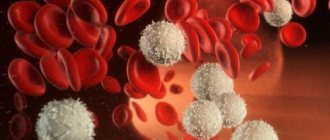Characteristics of the study
ESR is an indicator of the rate of separation of blood in a test tube with an added anticoagulant into 2 layers: upper (transparent plasma) and lower (settled red blood cells). The erythrocyte sedimentation rate is estimated by the height of the formed plasma layer in mm per 1 hour. The specific gravity of erythrocytes is higher than the specific gravity of plasma, therefore, in the presence of an anticoagulant, under the influence of gravity, erythrocytes settle to the bottom. The rate at which erythrocyte sedimentation occurs is mainly determined by the degree of their aggregation, that is, their ability to stick together.
The aggregation of erythrocytes mainly depends on their electrical properties and the protein composition of the blood plasma. Normally, red blood cells carry a negative charge (Z-potential of red blood cells), which is caused by charged sialic acid groups on the erythrocyte membrane, which contributes to their mutual repulsion and maintenance of red blood cells in a suspended state. The degree of erythrocyte aggregation (and therefore ESR) increases with increasing concentration of acute phase proteins (fibrinogen, C-reactive protein, haptoglobin, alpha-1 antitrypsin, ceruloplasmin, immunoglobulins, etc.). On the contrary, ESR decreases with increasing albumin concentration. Other factors also influence the Z-potential of erythrocytes: plasma pH (acidosis reduces ESR, alkalosis increases), ionic charge of plasma, lipids, blood viscosity, the presence of anti-erythrocyte antibodies. The number, shape and size of red blood cells also affect ESR. A decrease in the number of red blood cells (anemia) in the blood leads to an acceleration of ESR, and, on the contrary, an increase in the number of red blood cells slows down the sedimentation rate.
In acute inflammatory and infectious processes, an increase in ESR is observed 24 hours after an increase in temperature and an increase in the number of leukocytes. The ESR indicator varies depending on many physiological and pathological factors. ESR rates in women are slightly higher than in men. Changes in the protein composition of the blood during pregnancy lead to an increase in ESR during this period. The values may fluctuate during the day; the maximum level is observed during the daytime.
Measuring ESR should be considered a screening test that is not specific for any disease. Typically, an ESR test is prescribed along with a general blood test.
ESR in blood test
The essence of testing blood for ESR is that red blood cells are the heaviest elements of blood plasma. If you place a test tube with blood vertically for some time, it will separate into fractions - a thick sediment of brown red blood cells at the bottom, and translucent blood plasma with the rest of the blood elements at the top. This separation occurs under the influence of gravity.
Red blood cells have a peculiarity - under certain conditions they “stick” together, forming cell complexes. Since their mass is much greater than the mass of individual red blood cells, they settle to the bottom of the test tube faster. During the inflammatory process occurring in the body, the rate of red blood cell union increases or, conversely, decreases. Accordingly, the ESR increases or decreases.
The accuracy of blood testing depends on the following factors:
- Proper preparation for analysis;
- Qualifications of the laboratory assistant conducting the research;
- Quality of the reagents used.
If all requirements are met, you can be confident in the objectivity of the research result.
Research methods
To determine ESR, the International Committee for Standardization in Hematology (ICSH) recommends the Westergren method. The method is a reference. The study is carried out in special Westergren capillaries with a lumen of 2.5 mm and a graduated scale of 200 mm. The results of the ESR study are expressed in mm per 1 hour (mm/hour).
In our country, the Panchenkov micromethod is more often used; for this method, a Panchenkov apparatus is used, consisting of a tripod and capillary pipettes with a 100 mm scale.
The results obtained when using the Westergren method, in the range of normal values, coincide with the results obtained when determining ESR using the Panchenkov method. However, the Westergren method is more sensitive to an increase in ESR, and the results in the zone of increased values obtained by the Westergren method are higher than the results obtained by the Panchenkov method.
Study of ESR in the laboratories of the CITILAB Association
The determination of ESR in the laboratories of the Association is carried out using the classical Westergren method on automatic StaRRsed analyzers from Radiomet. This analyzer automatically takes a sample, dilutes it with citrate in the required ratio, and the research results are sent to the information system. In addition, the technological features of the device allow automatic corrections to be made to the ambient temperature. When conducting research, the so-called “human factor” is completely excluded.
According to the nomenclature of studies in CITILAB laboratories, this study is: 11-10-003 - ESR (Westergren)
Taking blood for testing:
The blood is taken into a vacuum tube with EDTA.
Units: mm/hour
Reference values*:
| Age, gender | ESR, mm/hour | |
| Children under 10 years old | 0 — 10 | |
| Up to 50 years | men | 0 — 15 |
| women | 0 — 20 | |
| Over 50 years old | men | 0 — 20 |
| women | 0 — 30 | |
Note: * - Bottiger LE, Svedberg CA. Normal erythrocyte sedimentation rate and age. Br Med J 1967;2:85-7.
The ESR rate depends on gender and age
The gender and age of the subjects influence the ESR values taken as the norm.
- In healthy newborns – 1-2 mm/hour. The reasons for deviations from standard indicators are acidosis, hypercholesterolemia, high hematocrit;
- in children 1-6 months – 12-17 mm/hour;
- in preschool children – 1-8 mm/hour (equal to the ESR of adult men);
- For men – no more than 1-10 mm/hour;
- In women - 2-15 mm/hour, these values vary depending on the level of androgen; from the 4th month of pregnancy, ESR increases, reaching 55 mm/hour by childbirth, after childbirth it returns to normal within 3 weeks. The reason for the increase in ESR is the increased level of plasma volume in pregnant women, cholesterol levels, and globulins.
An increase in indicators does not always indicate pathology; the reason for this may be:
- Use of contraceptives, high molecular weight dextrans;
- Fasting, dieting, lack of fluid, leading to the breakdown of tissue proteins. A recent meal has a similar effect, so blood is taken to determine ESR on an empty stomach.
- Increased metabolism caused by physical activity.
Changes in ESR depending on age and gender
| Age | ESR rate (mm/hour) |
| Newborn babies | 0-2 |
| Infants up to 6 months | 12-17 |
| Children and teenagers | 2-8 |
| Women under 60 years old | 2-12 |
| Women in the 2nd half of pregnancy | 40-50 |
| Women over 60 years old | Up to 20 |
| Men under 60 years old | 1-8 |
| Men over 60 years old | Up to 15 |
Acceleration of ESR occurs due to an increase in the level of globulins and fibrinogen. Such a shift in protein content indicates necrosis, malignant transformation of tissue, inflammation and destruction of connective tissue, and immunity disorders. A prolonged increase in ESR above 40 mm/hour requires other hematological studies to determine the cause of the pathology.
Table of ESR norms for women by age
Indicators found in 95% of healthy people are considered the norm in medicine. Since a blood test for ESR is a nonspecific test, its indicators are used in diagnosis together with other tests.
| Age | Norm (mm/hour) |
| Girls under 13 years old | 7-10 |
| Girls - teenagers | 15-18 |
| Women of reproductive age | 2-15 |
| Women over 50 years old | 15-20 |
According to the standards of Russian medicine, the normal limits for women are 2-15 mm/hour, abroad – 0-20 mm/hour.
The normal values for a woman fluctuate depending on changes in her body.
Indications for a blood test for ESR in women:
- Anemia,
- Lack of appetite,
- Pain in the neck, shoulders, headache,
- Pain in the pelvic organs,
- Joint pain,
- Unreasonable weight loss.
Norm of ESR in pregnant women depending on completeness
| Body type | Norm ESR (mm/hour) in the 1st half of pregnancy | Norm ESR (mm/hour) in the 2nd half of pregnancy |
| Fat women | 18-48 | 30-70 |
| Skinny women | 21-62 | 40-65 |
ESR in pregnant women depends directly on the level of hemoglobin.
Normal ESR in the blood of children
| Age | ESR rate (mm/hour) |
| At birth | 1-2 |
| Day 8 | 4 |
| Day 14 | 17 |
| Over 2 weeks | About 20 |
| In preschool children | 1-8 mm/hour |
Increase (acceleration) of ESR
- inflammatory diseases of various etiologies;
- acute and chronic infections;
- paraproteinemia (multiple myeloma, Waldenström's disease);
- tumor diseases;
- autoimmune diseases (collagenosis);
- kidney diseases (chronic nephritis, nephrotic syndrome);
- myocardial infarction;
- hypoproteinemia;
- anemia;
- intoxication;
- injuries, bone fractures;
- conditions after shock, surgical interventions;
- in women during pregnancy, menstruation, and the postpartum period;
- in elderly people;
- when taking medications (estrogens, glucocorticoids).
To obtain comparable results and monitor the dynamics of the disease, it is recommended that studies be carried out in the same laboratory. However, patients who have conducted research in different laboratories sometimes contact their attending physicians, and the results of the research are difficult to compare (especially if the research was carried out using different methods, for example, Westergren and Panchenkov). As mentioned above, the results obtained using the Westergren method in the region of normal values coincide with the results of the Panchenkov method, but at high ESR values there is no such coincidence.
To facilitate the interpretation of the results of the ESR study, our doctors developed a table of correspondence of the results obtained by the Westergren and Panchenkov methods.
Table 1.
Appointment for analysis
A blood test for ESR is prescribed to identify the inflammatory process and monitor the treatment of the disease.
A blood test containing ESR is prescribed for any disease, suspected disease, to clarify the diagnosis, to check the effectiveness of treatment and simply for routine checks.
The analysis is prescribed by a therapist, hematologist, or oncologist if necessary. An analysis prescribed by a doctor is carried out free of charge in the laboratory of the clinic to which the patient is assigned. The patient can also take a blood test in any paid laboratory of his choice.
A blood test for ESR is prescribed in the following cases:
- If rheumatic disease is suspected. Rheumatic diseases (lupus, gout, rheumatoid arthritis) affect connective tissue and joints. They manifest themselves in joint deformation, fever, pain during movement, and stiffness. For such diseases, a blood test is required; the ESR will be increased.
- With myocardial infarction. During myocardial infarction, blood circulation in one or more arteries of the heart is disrupted. Despite beliefs that a heart attack occurs suddenly, it can be prevented, since symptoms begin to appear in advance, sometimes a month before the attack itself. During an attack, the patient experiences severe pain in the chest, panic, pain spreading to the shoulder and neck. If you experience pain, even mild pain, you should consult a doctor and undergo an examination.
- During pregnancy, to check the condition of the mother and child. During pregnancy, a woman often donates blood. All blood parameters are checked and carefully assessed. However, ESR may be increased during pregnancy, and this is considered normal due to changes in the body.
- If a tumor is present, to check its growth. A blood test will help not only check the effectiveness of treatment, but also diagnose or suspect the presence of a tumor at an early stage. An increased level of ESR and other indicators only indicate an inflammatory process, which can be anything from ARVI to cancer. However, this is an impetus for further examination.
- If a bacterial infection is suspected. With a bacterial infection, the ESR will be elevated, but this may also be a sign of a viral infection. Therefore, additional tests are performed before starting treatment.
Preparation and procedure
Blood test for ESR
For examination, as a rule, venous blood is taken. During the analysis, not only the ESR is determined, but also the entire list of indicators, and the doctor will look at the result as a whole. ESR is not assessed individually, but in combination with other markers of inflammation.
For this reason, it is advisable to prepare for the analysis in order to obtain reliable results:
- Blood must be donated on an empty stomach. If the level of glucose in the blood is determined and it is important to get an accurate figure, it is not recommended not only to eat and drink, but also to brush your teeth before the analysis. You can drink still water 2-3 hours before the procedure.
- It is not recommended to drink alcohol at least one day before the test. It is also better to limit smoking or at least abstain from it in the morning on the day of blood donation. Smoking and alcohol can affect all indicators.
- On the eve of the test, you should stop taking any medications. Hormonal contraceptives and multivitamin complexes cause an increase in ESR in the blood. If it is impossible to stop taking the drug, you must inform your doctor about all medications you are taking.
- It is better to come to the laboratory early to sit in the corridor and catch your breath. On the day of blood donation and the day before, it is better to avoid physical and nervous stress.
- ESR is sensitive to the phases of the cycle in women. Before taking the test, it is advisable to check with your doctor when exactly is the best time to donate blood.
- On the eve of the analysis, you should refrain from fatty and spicy foods, fast food, and carbonated drinks. This is important not only for liver and pancreas indicators. Food can affect many indicators and even cause hormonal changes.
Some procedures, especially invasive ones, can affect blood counts. Any procedures must be reported to the doctor before the blood donation procedure. Perhaps he will advise you to postpone the tests.
The procedure itself is fairly quick and, as a rule, painless.
The nurse in the laboratory will take blood from a vein and tell you when to come for the result. If you feel unwell or dizzy during blood sampling, you should definitely inform the nurse about this.
ESR 25 in women: reasons for the increase
An increase in the level of ESR in the blood indicates the presence of an inflammatory process
A doctor should decipher the results. Even knowing the norm will not always help determine the disease. The doctor will examine the entire result, evaluate all indicators and prescribe further examination.
Normally, ESR in an adult is 2-15 mm/h in women and 1-10 mm/h in men. An ESR of 25 in women is considered elevated, but during pregnancy the norm rises to 45 mm/h.
An increase in ESR is observed in the following conditions and diseases:
- Myocardial infarction. A heart attack is also accompanied by an inflammatory process, which means an increase in ESR. ESR can also increase in the post-infarction state, as well as other diseases of the blood vessels, arteries, thrombosis, which can ultimately lead to myocardial infarction.
- Inflammatory diseases and infections. ESR increases with any inflammatory process in the body. It will be difficult to determine its location using a blood test. It is important to consider the symptoms. For example, with a sore throat and fever, an elevated ESR may indicate a sore throat. With frequent urination, blood in the urine, and lower back pain, pyelonephritis or other inflammatory diseases of the kidneys and bladder can be suspected.
- Tumors. I rarely use ESR when diagnosing cancer, since it can increase for a variety of reasons or even for no reason. But it has been observed that cancer patients always have elevated ESR levels. The absence of obvious symptoms and other signs of inflammation, but an ESR level above 70 mm/h are possible indicators of a tumor.
The reasons for the decrease in ESR are rarely discussed, since the lower limit tends to zero and the reduced rate has no clinical significance. We can talk about a decrease in ESR if, normally, this indicator in a healthy person is usually elevated, but suddenly decreased sharply. The reasons for this decrease may be dehydration, pregnancy, cardiac or respiratory failure, or serious liver disease. ESR is often low in heavy smokers.
Correspondence of ESR results obtained by Westergren and Panchenkov methods
| IN | P | IN | P | IN | P | IN | P |
| 1 | 1 | 31 | 27 | 61 | 48 | 91 | 66 |
| 2 | 2 | 32 | 27 | 62 | 49 | 92 | 67 |
| 3 | 3 | 33 | 28 | 63 | 49 | 93 | 67 |
| 4 | 4 | 34 | 29 | 64 | 50 | 94 | 68 |
| 5 | 5 | 35 | 30 | 65 | 50 | 95 | 68 |
| 6 | 6 | 36 | 30 | 66 | 51 | 96 | 69 |
| 7 | 7 | 37 | 31 | 67 | 52 | 97 | 69 |
| 8 | 8 | 38 | 32 | 68 | 52 | 98 | 70 |
| 9 | 9 | 39 | 33 | 69 | 53 | 99 | 70 |
| 10 | 10 | 40 | 33 | 70 | 54 | 100 | 71 |
| 11 | 11 | 41 | 34 | 71 | 54 | 101 | 71 |
| 12 | 12 | 42 | 35 | 72 | 55 | 102 | 72 |
| 13 | 13 | 43 | 36 | 73 | 55 | 103 | 72 |
| 14 | 14 | 44 | 36 | 74 | 56 | 104 | 73 |
| 15 | 14 | 45 | 37 | 75 | 57 | 105 | 73 |
| 16 | 15 | 46 | 38 | 76 | 57 | 106 | 74 |
| 17 | 16 | 47 | 38 | 77 | 58 | 107 | 74 |
| 18 | 17 | 48 | 39 | 78 | 59 | 108 | 75 |
| 19 | 17 | 49 | 40 | 79 | 59 | 109 | 75 |
| 20 | 18 | 50 | 40 | 80 | 60 | 110 | 76 |
| 21 | 19 | 51 | 41 | 81 | 60 | 111 | 76 |
| 22 | 20 | 52 | 42 | 82 | 61 | 112 | 77 |
| 23 | 21 | 53 | 43 | 83 | 61 | 113 | 77 |
| 24 | 21 | 54 | 43 | 84 | 62 | 114 | 78 |
| 25 | 22 | 55 | 44 | 85 | 63 | 115 | 78 |
| 26 | 23 | 56 | 45 | 86 | 63 | 116 | 79 |
| 27 | 24 | 57 | 45 | 87 | 64 | 117 | 79 |
| 28 | 24 | 58 | 46 | 88 | 64 | 118 | 80 |
| 29 | 25 | 59 | 47 | 89 | 65 | 119 | 80 |
| 30 | 26 | 60 | 47 | 90 | 65 | 120 | 81 |
Note: ESR results are presented in mm/hour; B - Westergren method; P - Panchenkov method.
Bibliography
- Lugovskaya S.A., Dolgov V.V. Laboratory Hematology. Tver, Triad, 2006.
- Bottiger LE, Svedberg CA. Normal erythrocyte sedimentation rate and age. Br Med J 1967;2:85-7.
- Brigden M. The erythrocyte sedimentation rate: still a helpful test when used judiciously. Postgrad Med 1998;103:257-74.
- Saadeh C. The erythrocyte sedimentation rate: old and new clinical applications. South Med J 1998; 3:220-5.
- Sox HC Jr, Liang MH. The erythrocyte sedimentation rate: guidelines for rational use. Ann Intern Med 1986;104:515-23.
- Stuart J, Whicher JT. Tests for detecting and monitoring the acute phase response. Arch Dis Child 1988;63:115-7.
- Wolfe F, Michaud K. The clinical and research significance of the erythrocyte sedimentation rate. J Rheumatol 1994;21:1227-37.
Author:
Baktyshev Alexey Ilyich, General Practitioner (family doctor), Ultrasound Doctor, Chief Physician






